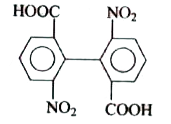Which of the following compounds exhibit optical isomerism?

H2C=C=CH2


The correct Answer is:A, C
To determine which of the given compounds exhibit optical isomerism, we need to identify if any of the compounds contain a chiral carbon atom. A chiral carbon is defined as a carbon atom that is bonded to four different substituents, leading to non-superimposable mirror images (enantiomers).
1. Identify the Compounds: Review the provided compounds to see their structures. We need to analyze each compound for the presence of a chiral carbon.
2. Check for Chiral Centers: For each compound, locate the carbon atoms and check if any of them are bonded to four different groups or atoms.
- Compound 1:
- Consider a specific carbon atom in the compound.
- This carbon is bonded to a carboxylic acid group (COOH), a hydrogen atom (H), a CH2 group, and a CH group.
- Since all four substituents are different, this carbon is a chiral center.
- Compound 2:
- Check the carbon atoms in this compound.
- If any carbon has a double bond or is bonded to identical groups, it cannot be chiral.
- This compound has a double bond, which eliminates the possibility of having a chiral center.
- Compound 3:
- Similar to Compound 2, check for double bonds or identical groups.
- If a carbon is bonded to two of the same groups or has a double bond, it cannot be chiral.
- Compound 4:
- Again, check for the presence of double bonds or identical groups.
- If the structure shows any double bonds or symmetry, it cannot have a chiral center.
3. Conclusion: After analyzing all compounds, only Compound 1 exhibits optical isomerism due to the presence of a chiral carbon atom with four different substituents. The other compounds do not meet the criteria for optical isomerism.
Final Answer:
Only Compound 1 exhibits optical isomerism.
- Consider a specific carbon atom in the compound.
- This carbon is bonded to a carboxylic acid group (COOH), a hydrogen atom (H), a CH2 group, and a CH group.
- Since all four substituents are different, this carbon is a chiral center.
- Check the carbon atoms in this compound.
- If any carbon has a double bond or is bonded to identical groups, it cannot be chiral.
- This compound has a double bond, which eliminates the possibility of having a chiral center.
- Similar to Compound 2, check for double bonds or identical groups.
- If a carbon is bonded to two of the same groups or has a double bond, it cannot be chiral.
- Again, check for the presence of double bonds or identical groups.
- If the structure shows any double bonds or symmetry, it cannot have a chiral center.
Only Compound 1 exhibits optical isomerism.
Similar Questions
Knowledge Check
Which of the following compounds exhibits linkage isomerism?
A[Co(en)3]Cl3B[Co(NH3)6][Cr(en)3]C[Co(en)2(NO2)Cl]BrD[Co(NH3)5Cl]Br2Which of the following compound shows optical isomerism ?
ACH3CH2CH3BCH2OHCHOHCH2OHCCH3CHOHC2H5DNone of these
Which of the following compound show optical isomerism?
View SolutionWhich of the following compound show optical isomerism?
View SolutionWhich of the following compound will show optical isomerism
View SolutionWhich of the following compounds can show Optical isomerism as well as geometrical isomerism?
View SolutionWhich of the following can exhibit geometrical isomerism?
View SolutionWhich of the following compounds will exhibit tautomerism?

View Solution
